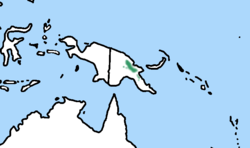| Blue bird-of-paradise | |
|---|---|
 | |
| Scientific classification | |
| Kingdom: | Animalia |
| Phylum: | Chordata |
| Class: | Aves |
| Order: | Passeriformes |
| Family: | Paradisaeidae |
| Genus: | Paradisornis Finsch & Meyer, A.B., 1886 |
| Species: | P. rudolphi |
| Binomial name | |
| Paradisornis rudolphi | |
 | |
| Range of P. rudolphi | |
| Synonyms | |
| |
The blue bird-of-paradise (Paradisornis rudolphi) is a large species of bird-of-paradise. It is the only species in the genus Paradisornis, but was previously included in the genus Paradisaea .
Contents
- Taxonomy
- Description
- Behaviour and ecology
- Diet
- Breeding
- Status and conservation
- Gallery
- References
- External links
It is often regarded as one of the most fabulous and extravagant of all birds of the world, with its glorified and fancy flank feathers present only in males and the two long wires also only found in the males.


















